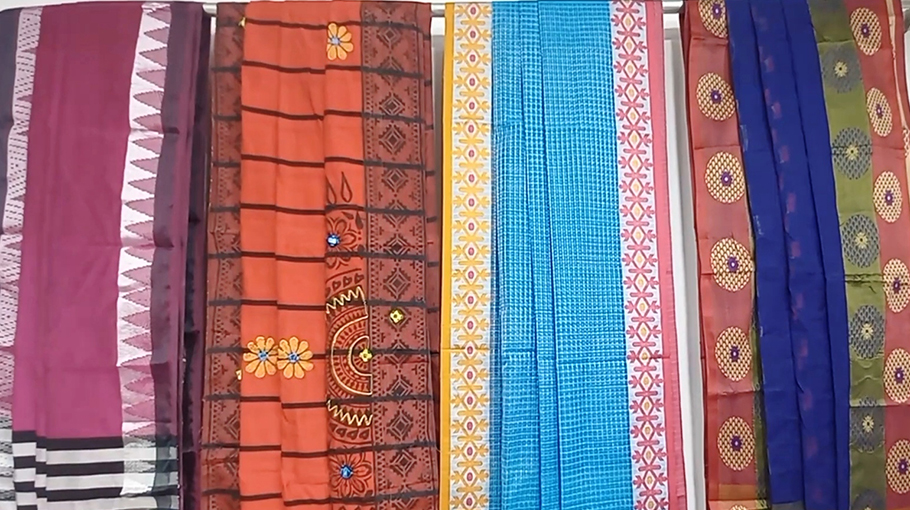Manipuri sari of Sylhet bearer of culture and tradition

The history of the weaving industry in Bangladesh is ancient. This industry is associated with its culture. In addition, the weaving industry is one of the holders and carriers of our heritage. It is also the largest cottage industry or folk industry in the country. The Manipuri textile industry of Sylhet is one of the largest contributors to this industry.
Famous travelers Ibn Battuta and Hiuen Sang's travelogues mention Manipuri textile art. From that aspect, it can be said that the tradition of the Manipuri weaving industry is very old; it is our tradition and culture of thousands of years.
Manipuri is the name of an ethnic group living in Bangladesh. Their original settlement is in Manipur state of India. Manipuris have their language and culture. At present, more than one and a half lakh Manipuri people live in Bangladesh. Once upon a time, Manipuri women used to weave cloth at home for their own use. Almost every house had a loom at one time. Although it has decreased nowadays, many people have kept their traditions. Even now, at least one in every four homes has a handloom weaving machine. Manipuri women weavers learn weaving from their mothers by birth. There is a saying - Manipuri girls are weavers by birth and almost 90 percent of women are associated with weaving.
These Manipuris live in different areas of Sylhet, Sunamganj, Habiganj, and Moulvibazar. Although this Manipuri weaving industry exists in different parts of Sylhet, it is large in the Moulvibazar district. These weavers live in about 50/60 villages of Kamalganj in the Moulvibazar district of Sylhet. Earlier Bishnupriya and Maitai Manipuris used to make their daily essentials including sarees. But due to the increasing demand for it day by day and the introduction of Manipuri products in the country and abroad, Muslim women have also joined this profession.
At present Manipuri, sarees are famous worldwide beyond the borders of the country. The patterned sarees catch the eye from afar. The temple border of the saree is one of its features. Again, one of the characteristics of sarees is that the sarees are completely hand-woven. As the sarees are hand woven, there is no difference between the front and the back, both sides can be used equally. The work designs of Manipuri sarees are never similar to each other. Because the weavers make the sarees according to their minds, the happiness-sadness, laughter-crying, and daily life of their lives are connected with the craft of this saree. However, Manipuri sarees are characterized by their mesh weave. However, due to the increase in the demand for sarees, some density is being increased in the weaving of good quality sarees. The tighter the weave and the more finishing it requires, the more yarn and time it takes.
There is no touch of the machine in making Manipuri sarees. Because the sarees are completely handmade, there are no black spots on the loom or white spots on the starch. People who don't know about Manipuri think that these are defects of the saree but these are the characteristics of the original Manipuri saree. Due to the increasing demand for Manipuri sarees, there has naturally been a trend to add innovation to its traditional designs. Since this saree is designed completely by hand, the time to make the saree increases as the design increases. Because of this, the price of the Manipuri saree has increased a little.
Manipuri women are very skilled in this art. Manipuri's saree weaving process is also similar to jamdani or desi loom sarees. Two weavers work on a loom sitting on either side. First, the yarn should be dried with starch. Then the dried yarn is twisted in a spinning wheel and filled into a knot and from there it is woven into a maku. And first of all, the saree has to be tied. Then the knitting goes on. It takes four to five days to weave a saree. However, the weaving time depends on the color and design of the saree.
The textile products produced by Manipuri include - the Fanek (a special type of dress of Manipuri) saree, shawl, veil, three-piece, towel, fatwa, Punjabi, bed sheet, etc.
In the Manipuri language, the loom is called 'yong'. Yong is again of two types. Moang and Pang. Moang looms are usually made of coarse yarn. And Pang looms usually produce fine yarn fabrics.
Once the Manipuris used to weave cloth for their own needs, but gradually it has taken a commercial form. Because, Manipuri sarees are now preferred by fashion conscious women of any community due to the amalgamation of tradition and modernity. Traders say that the price of this saree is very high at present. Because the price of yarn and other materials for making saree has increased a lot. Many people are moving away from this profession. However, the demand for this saree is not decreasing at all.
This saree is now being exported abroad as well. Manipuri sarees are also available in tribals' own shops in different parts of the country including Dhaka and Sylhet.
Manipuri saree is suitable to wear on Turmeric, Mehndi festival, Pohela Baisakh or Pohela fhalgun, Farewell.
Generally, Manipuri sarees are priced between 600 and 4000 tk. But the price more or less depends on the design of the saree.
Several fashion houses have been built around this Manipuri saree in the tourist city of Sylhet. There are several Manipuri saree shops in the Lamabazar area of Sylhet city, where you can find traditional Manipuri weavers' sarees or clothes. Besides, several entrepreneurs have employed them by capitalizing on this industry. Those who are making money by selling these Manipuri sarees online.
Manipuri is one of the mediums of indigenous weaving. Further development of this industry requires public-private cooperation, necessary guidance and training. Only then this potential industry will maintain its existence in glory on earth.




